Portland anarchists crowned a season of monument destruction in October 2020 when they pulled down the city’s Teddy Roosevelt and Abraham Lincoln statues and attacked the nearby Oregon Historical Society—despite its having been so woke and feminist for years it could be called the Oregon Hysterical Society. This occurred on what Antifa organizers billed as an “Indigenous Day of Rage” (something that was about as genuinely “indigenous” as the Boston Tea Party) and coincided with Portland’s official (anti-) holiday refuting Columbus Day—Indigenous People’s Day—which promises to grow more strident and violent, if no more indigenous, annually.
Last October, the nation and the city weren’t as far gone as they are now. Portland Mayor Ted Wheeler felt compelled to stand with the police chief and denounce the rioters’ actions. But in doing so, he followed the same pattern he and the city used to acquiesce to anarchist and Black Lives Matter political terror over the summer of 2020: denouncing the violence, affirming the anarchists’ right to speech, even sympathizing with the goals of anti-police rioters, and conspicuously not defending their targets—then it was the police, in this instance, it was our history.
With virtually no defenders in Portland, the toppled presidents were quickly forgotten while the activists and the government combined to remake the city quietly and quickly. They moved to consolidate the gains achieved by their Antifa vanguard. The city has responded to the destruction of monuments with laws expediting the removal of so-called “white” monuments and replacing them with anti-white monuments.
Oregon politicians and the activist organizations they fund with tax dollars follow in Antifa’s footsteps to settle the occupied territory. It is unclear where one ends and the other begins. Many arrested rioters work for activist organizations, of course.
Portlanders subsidize the Regional Arts and Culture Council through a $35 per year arts tax; the city empowers that council with overseeing Portland’s public art and monuments. The city council member assigned as liaison (with attendant lack of authority) to the, naturally, very woke council is radical newcomer Carmen Rubio. Beyond that, RACC’s supposed private nature shields it from public oversight, though it is subject to audit.
Without public input RACC revised its policies last August, recommending the removal of any monument identified through “sustained and overwhelming public objection . . . [to] include regular social justice oriented graffiti, vandalism, or defacement . . . [or when the] subject or impact of an artwork is significantly at odds with values of antiracism, equity, inclusion.”
This September, a little less than a year after the “Indigenous” Day of Rage, RACC recommended not restoring four statues under its purview: Lincoln, Roosevelt, a statue of a settler family arriving in Oregon called “The Promised Land,” and a statue of longtime Oregonian editor and power broker Harvey Scott, who came to Oregon as a settler in 1852, losing his mother and a brother along the way. Aside from being an actual settler (and thus a “colonizer”) he opposed female suffrage. Fittingly, he was an expert on Oregon history, though it’s doubtful antifa saw the irony.
A 2018 city audit found RACC rudderless and unaccountable:
Auditors pointed out no one’s keeping tabs on the value of RACC’s public art assets. Take the famous Portlandia statue. Sculptor Raymond Kaskey got paid $348,000 by RACC to make it for the city in 1985. Today, it’s worth something like $4 million to $5 million. In case of a disaster, without an updated valuation, the city might not be able to recoup the full value.
Furthermore, the RACC contract is riddled with vague language about the agency’s mission, public records procedure and workings. At the top, the agency lacks a strategic plan to guide operations.
At the same time no one could be found to replace the outgoing director. The city council liaison at the time was Nick Fish, liberal Democrat from a venerable old political family. Fish passed away in 2020 and was replaced by the radical Carmen Rubio.
The “trans, queer, neuro-diverse artist, alchemist, and Marine Corps veteran” from Georgia Tech with “they” pronouns brought in to lead RACC in 2018 revamped and repurposed the council as a social justice agency; last week “they” announced “they’ll” be moving on to a gig in San Francisco, having dispatched with Portland’s problematic history in a timely fashion.
Such rewriting of policy to accommodate and accelerate the rewriting of history was going on throughout Portland city government in 2020. In June, when the police station and jail were under nightly siege, the city passed a resolution declaring the city’s “core values”:
The City of Portland is an anti-racist institution.
Addressing issues concerning anti-Blackness is a priority for the workforce and city.
Actions to dismantle institutional and systemic racism are the responsibilities of every employee and resident.
Racism, discrimination, and bias are not tolerated within the workplace or in our communities.
The City of Portland condemns oppression, violence, and hate speech toward people of color.
The resolution, passed unanimously, changes no law. But it is cited repeatedly now by various grievance groups demanding the city “live up to” these “core values” and hand over something from the city treasury—and by RACC when effecting their Cultural Revolution-style policy changes.
Regarding the “Indigenous Day of Rage” (which indifferent anarchists scheduled one day ahead of “Indigenous People’s Day” overshadowing it into oblivion) the actual indigenous of the region were the only group whose shock and disapproval can be taken as genuine—they thought Indigenous People’s Day was going to be about them:
. . . [a] member of the Portland Indian Leaders Roundtable . . . Paul Lumley was upset by the destruction for a few reasons, one being the damage done to the Oregon Historical Society. He said they just opened an exhibit that does a beautiful job of showcasing Native American history that has been appreciated by tribes across the Pacific Northwest.
Lumley said he remembered the day in 2015 when City Council made the declaration [recognizing Indigenous People’s Day].
‘It felt so good,’ recalled Lumley. ‘It felt like finally I didn’t have to keep fighting so hard for tribal rights, that we were going to be embraced by the city, and it just felt so warm and welcoming.’
The Indians are as ignored as they are invoked by white anarchists attacking white history. Indigenous Americans came to terms with the same history Antifa is trying to obliterate, after all, and it’s clear the anarchists clearly prefer the loud charisma of blacks to the laconic dignity of American Indians.
As the statues came down, Portland police stood down. The chief later claimed a shots-fired call across the river required too many cops, and the small force remaining could only watch the destruction. Eventually, a man from Washington state, Brandon Bartells, was arrested for driving the van that took down the Roosevelt statue; two others were apprehended for breaking the Historical Society’s windows and throwing lit flares inside. Bartells was arrested previously for violating the curfew in Kenosha, Wisconsin. He and one of the flare-throwers, another out-of-stater identified as Malik Fard Muhamad, were turned over to Portland Police by federal agents.
Muhamad drew federal charges for traveling from Indiana to riot in Portland; he was arrested by U.S. Marshals after the Portland Freedom Fund, which only posts bail for “Black, Brown and Indigenous folks,” broke its bank to put up the 10 percent on his $2.1 million bail for state charges. Bartells appears to have melted back into post-America. Let’s go (underground) Brandon! Whatever impulse in Portland there is to prosecute those responsible appears to have been sated.
No one seemed to notice, but the mayor did not dare defend Teddy Roosevelt or even Abraham Lincoln, much less the culture and history they represent. It was just the violence and illegality of it all that upset him. This was even more the case for the “antifa candidate” for mayor, Sarah Iannarone, with whom Ted Wheeler was locked in a close election battle. Each gave statements repudiating the tactics of the rioters. While Wheeler left his acquiescence to the anarchists’ goals implicit, Iannarone was explicit in her support and promised that, as mayor, she would move swiftly in taking down statues identified as objectionable, but in an orderly and legal fashion:
As your next Mayor, I’m ready to talk about how we move this city forward, from rethinking public safety to changing names and removing statues. If someone would like a statue removed, they can engage our public process to register that complaint and I’ll push City Council to listen and act swiftly. Our systems of government have long ignored problematic symbols and impacts of institutional racism, I am committed to changing that as mayor. People are hurting and that pain is valid. But anonymous acts of destruction outside of any agreed-upon process are toxic, unaccountable behavior that has no place in our city. We are not going to be governed by shooting paintballs. That’s not democracy, nor is it fair to those of us who believe in our public process.
Iannarone lost but her policy of expedited dismantlement proceeded, as well as the clause recognizing the authority of monument-defacing “social justice-oriented graffiti.” So, yes Sarah, we will be governed by “shooting paintballs.”
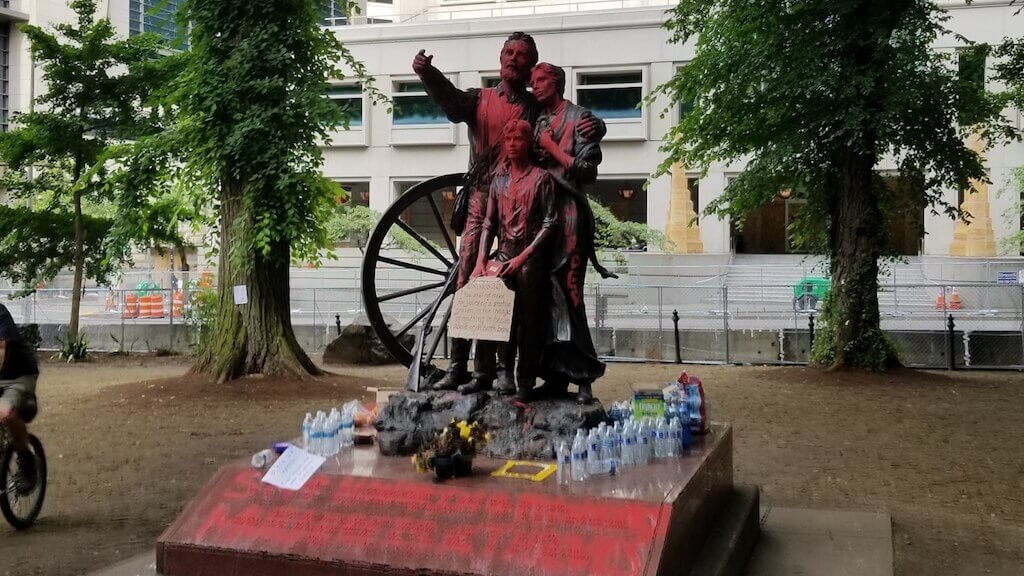
Also by way of taking over the process of replacing monuments, among other things, last July the city passed a new “master plan” for the city’s park blocks where the Lincoln and Roosevelt statues once stood. The plan has no public support (and is so far unfunded, at least) and among its goals the replacement of monuments with “public art representing more diverse cultural identities and histories” and the making of the park blocks more “accessible” to “the diverse,” somehow, despite the parks’ open spaces being the very definition of accessible.
Supposedly, the aforementioned lack of token monuments, the “Eurocentric” linear layout (for which there is no fix, sadly) and, even, the lack of indigenous trees—the blocks feature deciduous trees, many imported, rather than evergreens, allowing in more light in winter and dressing the blocks up with color in the fall—all serve to dissuade nonwhites from filling and ennobling the space.


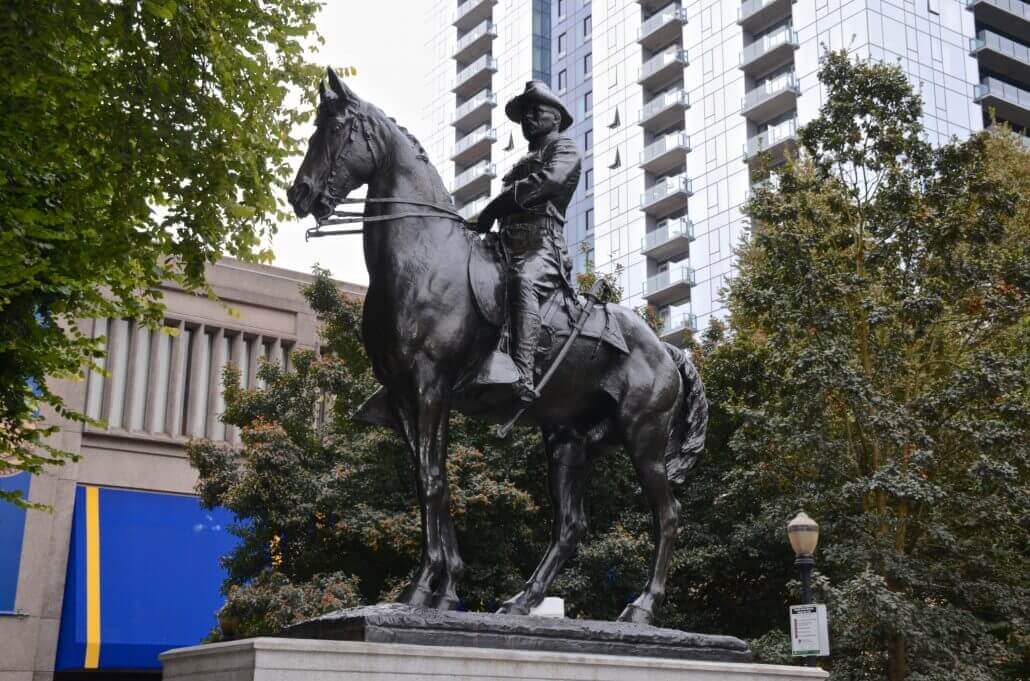

The plan has drawn opposition from influential Portlanders and the public lined up to denounce it before the council voted on it, to no avail; the council unanimously voted to open the area up to redevelopment, promising to ruin it with a “central promenade” connected to a broader bike loop routing bicycle traffic through the parks. The plan as a whole looks designed to adapt the parks to a denser city; indeed, it’s impossible to imagine the blocks keeping their present character of quiet refuge in the much more crowded Portland they plan to build around it.
Because the parks, originally donated in 1852, were for a time fronted by mansions today’s progressives include in their critique the notion they were created as a “backyard” for the city’s rich (and thus need to be redesigned). But the eventual design of the park blocks is partly a product, like Teddy Roosevelt whose statue is no longer welcome there, of the original Progressive Era, their layout and the monuments that graced them influenced by the “City Beautiful” movement of earnest wealthy white progressives. The naïve optimism and generosity of the original progressives stand in stark contrast to the cynicism of their nominal successors, who cheer on, oblivious, the dismantling of their legacy. Yesterday’s wealthy denizens of progress gave land to the common man; today’s give him indigenous land acknowledgments.
The park blocks are representative of whiteness, and thus are an affront to the new progressive and his very different idea of progress. They also connect present-day Portland to its white history. Of course, the park blocks have to be remade, toppled like the statues; they stand as a sort of nature preserve of the white history of Portland that these leftists want to abolish as fast as they can. Who knows, people might get nostalgic, imagine alternatives.
Last January the Downtown Neighborhood Association, one of the last bastions of resistance to total progressive control here, submitted a 100-page nomination of the blocks to the National Historic Registry, which would greatly restrict any changes to the parks. “A formal designation may help motivate retention of this valuable public space,” a Portland architect involved in the nomination understated.
Elsewhere a former dean of Lewis and Clark law school wrote an opinion piece recommending returning the statues so as to not reward vandalism and create a precedent—a little late for RACC’s “social justice-oriented graffiti” clause. While the city council is expected to follow whatever RACC recommends it isn’t required to, and Carmen Rubio has at least consented to take public comments on the policy change.
Meanwhile, leftists are moving forward to retrofit Oregon history in Portland with the reasonable expectation that none of the comments will make a difference. Per RACC’s Monuments and Memorials Project:
In 2020, Portland witnessed the removal of several monuments, including George Washington, Thomas Jefferson, Abraham Lincoln, The Promised Land, Harvey Scott, and others. Many more have been removed by activists and government officials across the country. As we enter into a national dialogue and reckon with historical narratives, contending with the monuments that have been created, we question not only who or what gets memorialized, but how we go about it. The questions and responses that arise from this moment are long overdue and ask what else is possible. It reminds us that public art can play an integral role in our society, activating and reflecting who we are and what we value.
Portland’s Monuments & Memorials Project will feature a series of talks with artists and scholars centered on various case studies of past, present, and proposed projects in public space. An inaugural discussion, held online on March 30, will focus on Alison Saar’s sculpture York: Terra Incognita, located at Lewis & Clark College.
As an integral part of the project, there will be an Open Call for Public Pedestals. Ideas for new and re-envisioned monuments and memorials will be solicited through an open call for proposals. Submissions will be gathered and shared in an online gallery and with civic leaders. A selection will be included in a culminating curated exhibition of regional and national artists exploring alternative perspectives of current and future monuments and memorials. The Project will conclude with a publication generated by the design team Omnivore, which will chronicle the ongoing activities as visual scribes, collecting, collating, and synthesizing the project’s findings.
The Public Art Collection has the power to create spaces that are inclusive and welcoming to all the communities living in the city. Conversely, public art in the form of historic monuments and memorials in these spaces frequently depicts figures or events seen through the lens of privilege, failing to recognize the nuance of history that contains dispossession, enslavement, and discrimination. The legacy of the people or events depicted can change over time and it is therefore imperative that these artworks be regularly reevaluated, taking into account new information that comes to light during research or based on the evolution of a changing community. Monuments and memorials may be considered for deaccession based on careful and in-depth evaluation of the artwork and are subject to the criteria stated above.
The “pedestal” project appears to be part of a broader theme of pedestal appropriation and may be inspired by the case of the Harvey Scott statue, toppled in Portland’s Tabor Park in another Antifa direct action, being briefly replaced by a “bust” of York, the slave who participated in the Lewis and Clark expedition; an unknown artist posted what looked like an oversized model head of a rather smug looking York on Scott’s pedestal. City council member Carmen Rubio declared herself “instinctively supportive” of the new statue.
Naturally, at least one crazy person not already on the Portland City Council was drawn to it. A woman was arrested and cited for painting the pedestal purple; video of the incident suggests mental illness. The city apologized that the polyurethane head would not hold up in the weather and would have to come down eventually. Things came to a head when vandals toppled York’s head and Portland’s Parks and Recreation promised to look into salvaging said head:
Adrienne Flagg, who has helped facilitate public art in the past, said she’s disappointed.
‘This was a really exciting piece of public art,’ Flagg said. ‘Although it didn’t come through official channels, it seemed to be very organic for our community and it was beautifully done.’
Lynda Martin-McCormick lives near the statue and said good art is meant to make people uncomfortable, but tearing the statue down was a political statement.
‘This was a political act by a faction of white people who want white people to stay on top, no matter what,’ said Martin-McCormick.
The director of Portland Parks and Recreation, Adena Long, said staff will inspect the bust to see if it can be salvaged.
‘Unfortunately, the numerous racist responses to the memorial of a Black man forced to participate in the Corps of Discovery Expedition have not been a surprise,’ said Long.



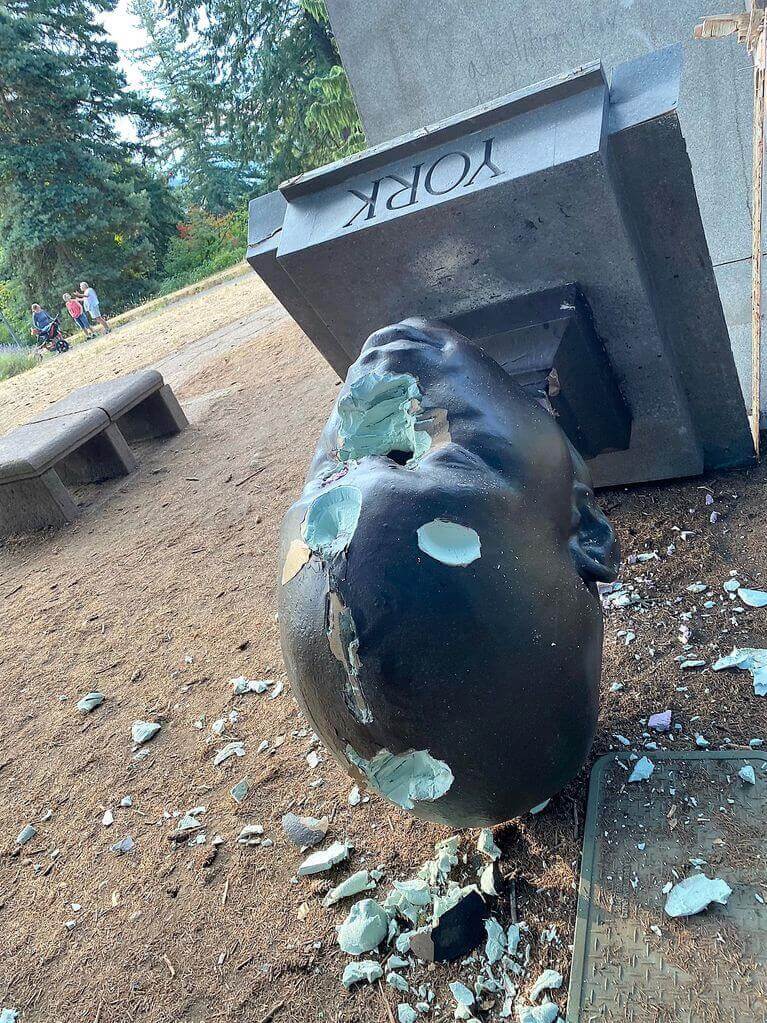
The pedestal of the George Washington bronze taken down from the lawn of the German American Society (who aren’t going to dare return the statue, taken down just a few years shy of its 100th birthday) was used in an aggressive work of propaganda that loomed over a street downtown for a time.
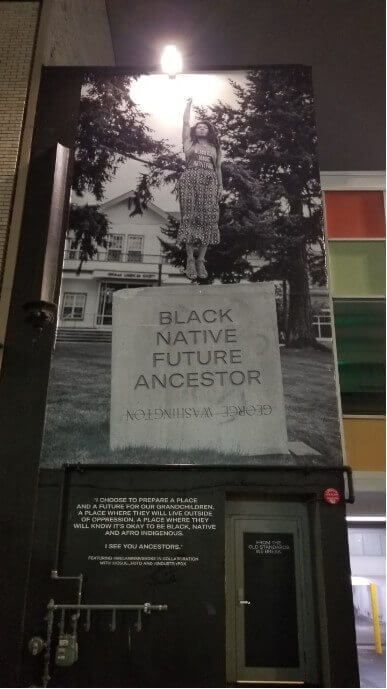
“George Washington” is crossed out on the overturned pedestal. An impressively “afro indigenous” looking model is rising up from it, fist raised. The text reads:
I choose to prepare a place and a future for our grandchildren, a place where they will live outside of oppression, a place where they will know it’s okay to be black, native and afro indigenous.
I see you ancestors.
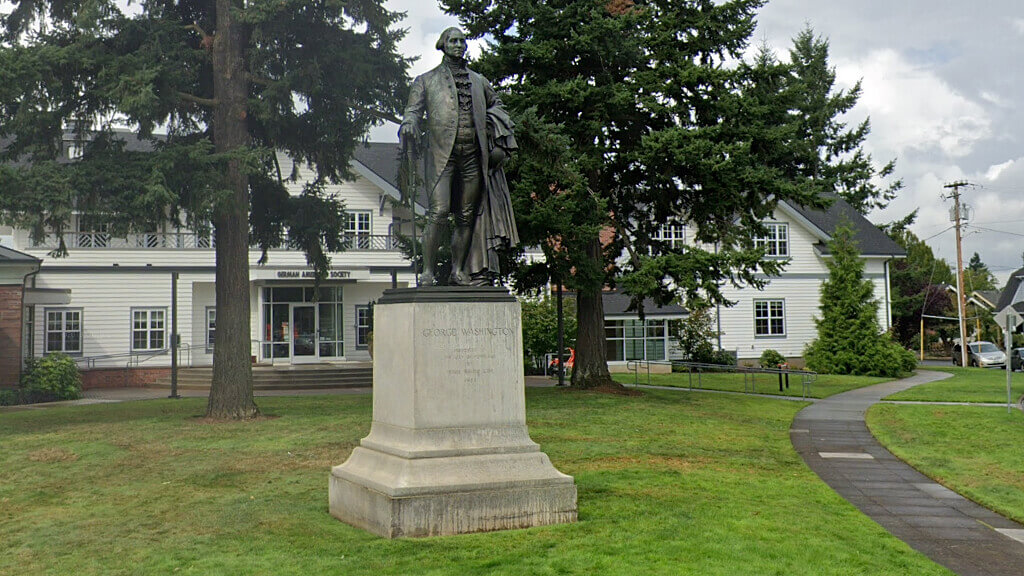
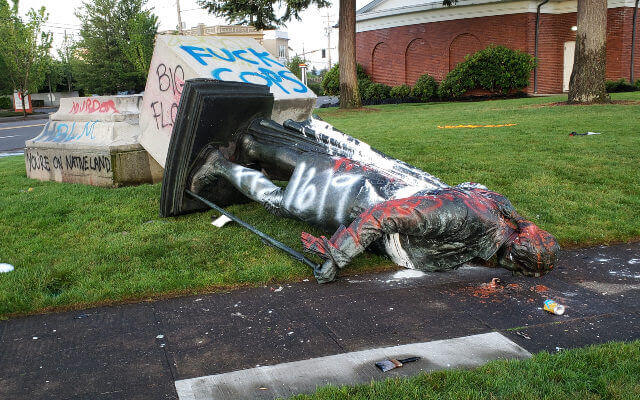
One statue will be returned: an inoffensive elk donated by a former mayor, which had to be removed because it was the center of Antifa bonfires nightly in the summer of 2020. Eventually, the fountain around it was removed by the city after Antifa had taken to pick-axing it into projectiles.
But city planners have already signaled they covet the choice plot on an island in the middle of a two-lane street in the center of downtown where the 120-year-old work stood, so the elk statue may soon be displaced by “progress,” just like the live elk it commemorates that once roamed here. But it will be a very different definition of progress than that which raised the statues and the parks.

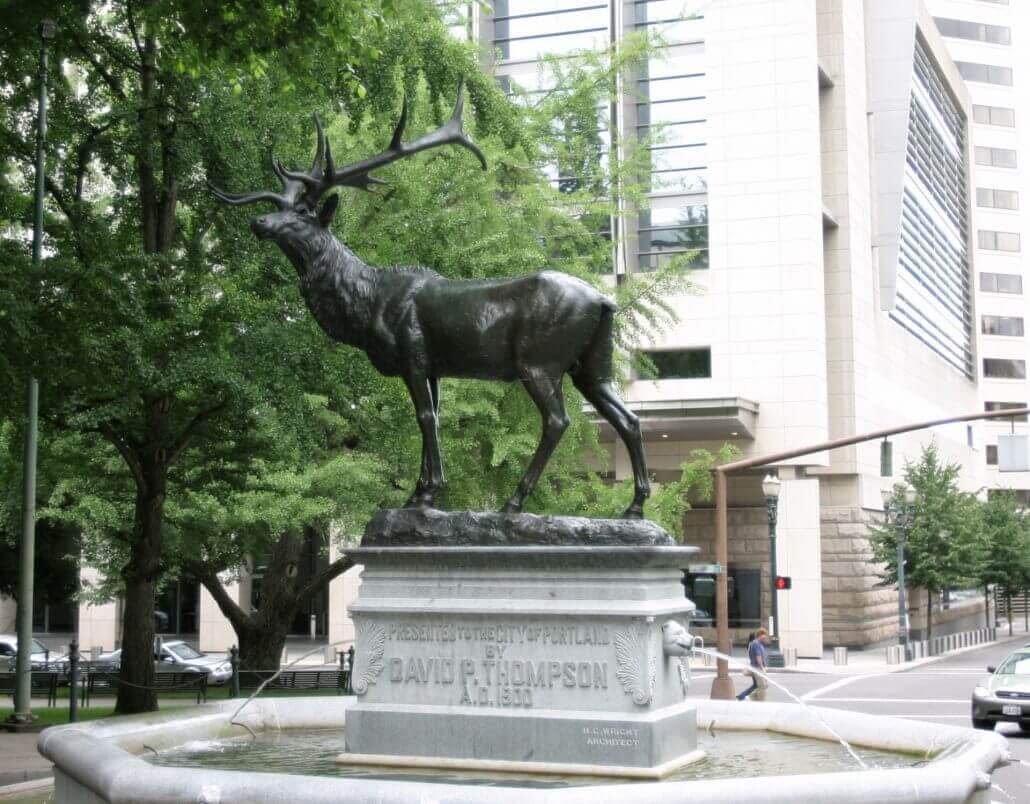
Still standing, for the moment: Soldier’s Monument, 1906, Lownsdale Park, memorializing Oregonians killed in the Spanish American War. The small cannons pointing north and south at the base are from Fort Sumter. Behind is the federal courthouse, still barricaded.

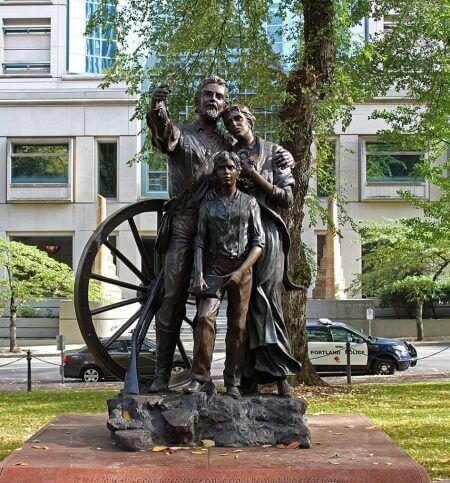
RACC subsidizes public art that is overwhelmingly woke, of course.
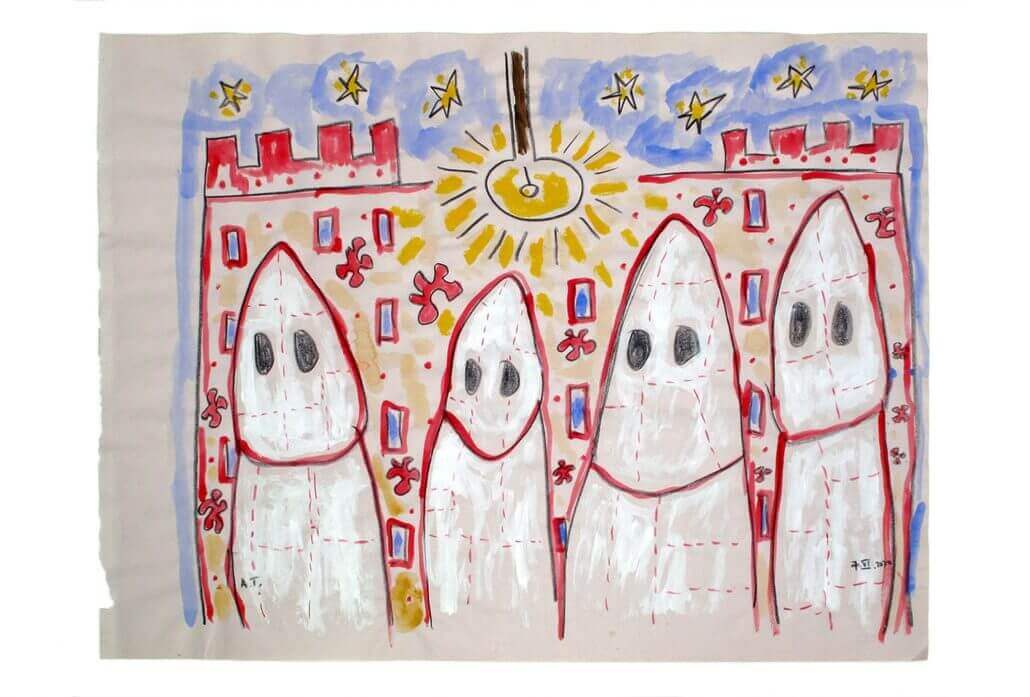
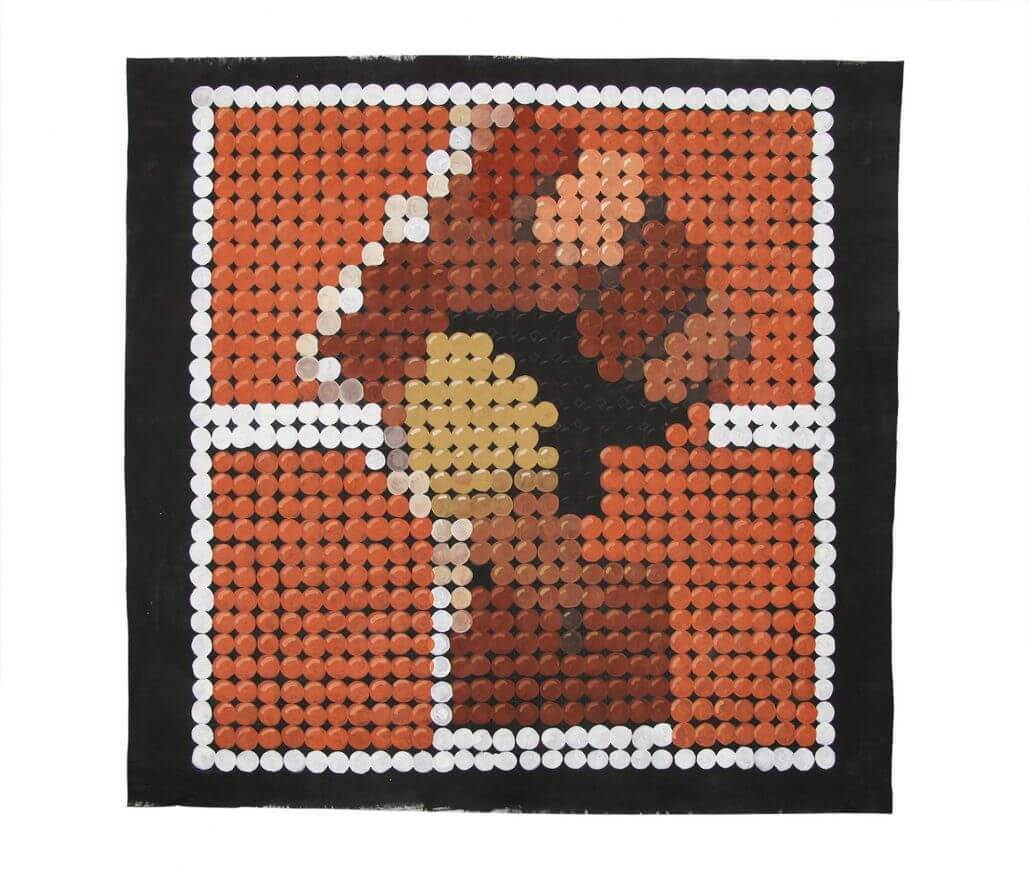
In 2020, at the same time the federal courthouse and police station were under nightly siege by what was already being fashioned a “racial reckoning” in the media, the new Multnomah County Courthouse was being completed a few blocks over. Heavy wood barriers were erected and remain in place to protect the building and its tall glass front.
Similar plywood barriers throughout town had become canvases for BLM and associated graffiti art already. Many murals of varying degrees of crudeness remain up as of this writing; Apple reclaimed its downtown store only after spending a year wrapped in and then donating the impromptu George Floyd mural that went up on its protective barriers, to a local BLM outfit, so as not to be seen as desecrating the art. The store now resembles a prison, shielded behind tall, steel-framed fencing anchored by concrete blocks.
A black judge invited schoolchildren to paint a mural on the boards put up to protect the new courthouse from peaceful protest vandalism. Thus was born the “aspirations for justice” mural project (because the current system of law can only be seen as aspiring to, never serving justice):
Inspired by art popping up around the city in response to the Black Lives Matter movement, Judge Oden-Orr called for a mural centered on racial justice to fill some of the space on the temporary walls outside the courthouse. Judge Oden-Orr said he feels strongly that, in all moments but particularly this one, it is the responsibility of the court to educate youth on their civil rights and to encourage engagement and activism. So, in fall of 2020 he began hosting conversations with youth from organizations across the Portland metro area.
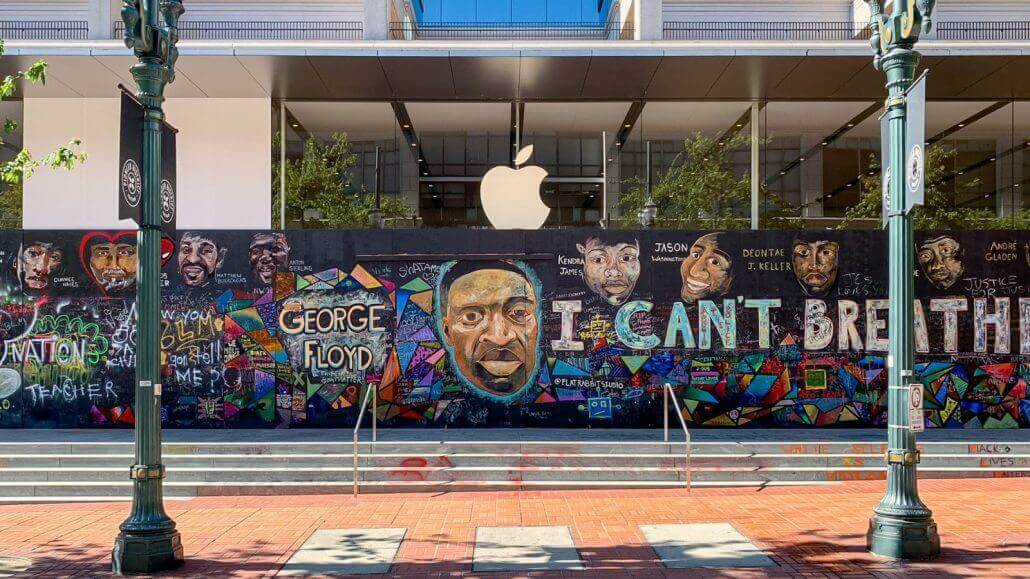
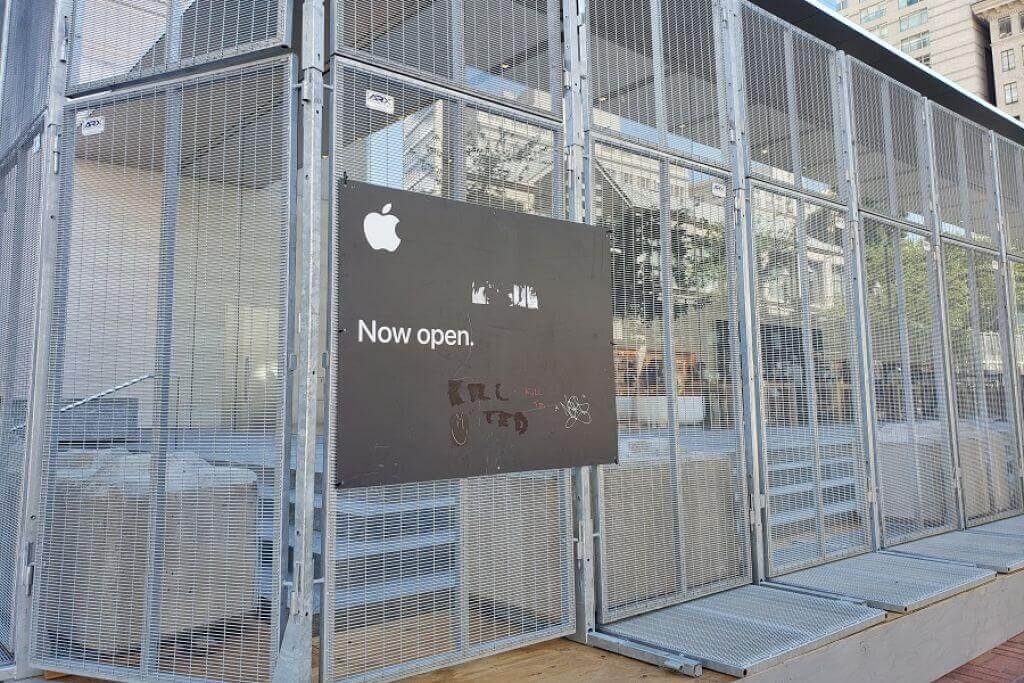

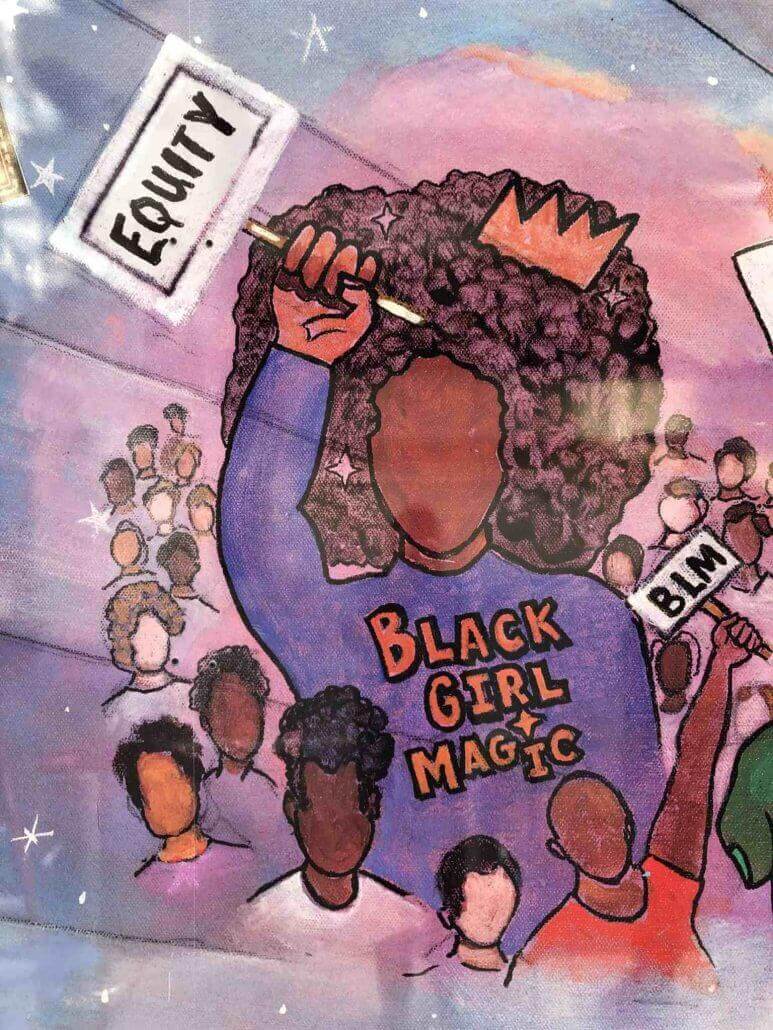

Grotesque diversity kitsch increasingly replaces the old settler history aesthetic in Portland. The city leads the nation in historical self-abnegation. It’s difficult to imagine a greater betrayal of a city’s founders and settler stock, with the comfortable decadents of the present distastefully tossing aside their sacrifice and giving their legacy over to the malicious and impressively mediocre.
Still, the field for the statue-toppling and school re-naming legacy levelers remains target-rich. Why, I just passed a street named “Custer” the other day. So much work still to be done!
Editor’s note: This article appeared originally at “Untethered.”
